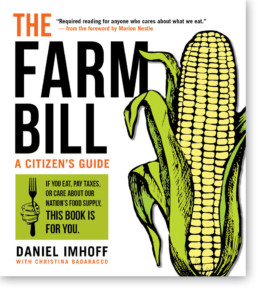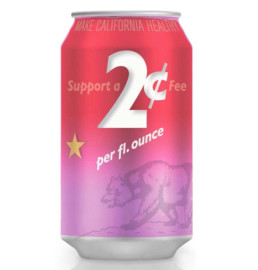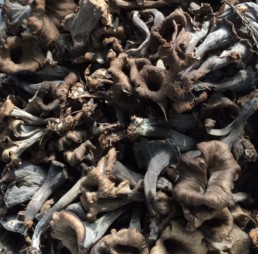Dan Imhoff’s Newly Revised Farm Bill Citizen’s Guide Released by Island Press
I
In January 2019, Island Press released Watershed Media co-founder Dan Imhoff’s third edition of his acclaimed primer on U.S. food and farm policy. The Farm Bill: A Citizen’s Guide was the result of a few years of research and revisions to the previous 2012 edition of the book, under the previous title, Food Fight. Christina Badaracco, graduate of the University of California at Berklee’s master program in public health, was a co-author on the project.
The book made immediate impact when Imhoff and Badaracco appeared in Washington DC in late January for a series of events which included a public talk at Busboys and Poets bookstore and a Congressional briefing co-sponsored by CA-Rep. Jared Huffman and OR-Rep. Earl Blumenauer. Watershed Media was extremely pleased to collaborate with Ricardo Salvador, Mike Lavender and Sarah Reinhardt of the Union of Concerned Scientists on these events.
In late March Imhoff travelled to Baltimore for an appearance at the Bloomberg School of Public Health at Johns Hopkins University. Co-authors Imhoff, Badaracco and economics professor Adam Sheingate spoke to a packed lunchtime auditorium that included professors, the public and students from a number of different programs within the university.
Press around the book has been steady. A number of interviews have been published including podcasts from the Institute for Agriculture and Trade Policy and Roots of Change. Imhoff also has contributed op-eds to Civil Eats, Environmental Health News, and the Sustainable Food Trust in the wake of the passage of the 2018 Farm Bill in December.
The latest edition of the Citizen’s Guide is nearly 300 pages long with over 50 updated charts and diagrams and a new format designed to make the technical language of the massive bill understandable to broad readership. The book also features a foreword by Marion Nestle, one of the country’s leading champions of food and farm policy reform.
The Farm Bill has already become a popular text for the burgeoning number of classes in sustainable food systems in universities around the country. The book is also a compelling resource to bring together various members of society to try to reform a critically flawed yet vitally important legislation. The early editions of this book inspired the City of Seattle to write its own Farm Bill Principles, which were later adopted by the National League of Cities.
Imhoff’s favorite story of how a book can activate audiences and influence influencers involves chef Michel Nischan and the group he co-founded, Wholesome Wave. Following the publication of the first edition of Food Fight, Imhoff was invited by Nischan to speak at the Westport Playhouse at a Wholesome Wave and American Farmland Trust event in 2007. It was attended by the late Gus Schumacher, a former Under Secretary of Agriculture at USDA and CT-Rep Rosa DeLauro, among others.
Inspired by a slide from Imhoff’s book that graphically represented how Farm Bill dollars are spent, Wholesome Wave began advocating for SNAP funds to be used to increase the affordability and availability of fresh fruits and vegetables to low-income Americans.
The effort evolved into the Food Insecurity Nutrition Incentives program (FINI) which helps SNAP recipients double their purchases of local produce at farmer’s markets and other retail points of sale. In the recently passed 2018 Farm Bill, the program received permanent funding status with a budget of up to $250 million per year for five years and is now known as The Gus Schumacher Nutrition Incentive Program.
California Soda Tax on Hold
Watershed Media has been providing support in the form of videos and graphics for a coalition of California activists working with health professionals and legislators to pass a 2 cent per ounce tax on sugar sweetened beverages. The California Community Health Fund (AB 138) would raise money to promote health programs, sustainable agriculture, and community development, has been under consider for many years. In 2019, the bill made it farther through the legislative process than in previous attempts. Unfortunately, it has been blocked from further action until at least January 2020.
Our media campaign was designed to engage citizens to lend their voices to this important initiative, which could generate billions of dollars to support critically needed programs. The powerful soda lobby is doing everything they can to stop legislation of this kind, which means donating tens of thousands of dollars to legislators on key committees. This is despite alarming trends which sugar sweetened beverages are fueling in the Golden State:
• $40 billion in annual costs of diabetes due to lost productivity and treatment;
• 15.5 million California adults who have diabetes or pre-diabetes;
• 12,500 amputations due to diabetes each year.
Roots of Change, the Public Health Institute and many other organizations continue to work for broader public awareness on the issue.
Despite Small Wins, the New Farm Bill is a Failure of Imagination
This article by Dan Imhoff originally appeared in Civil Eats, December 18, 2018.
The $867 billion 2018 Farm Bill the House and Senate passed this week is a hot mess. The Washington Post editorial board described it as “a bad outcome—that could have been worse.” And they’re right. Unfortunately, we’re all going to be affected by it.
Congress passes a farm bill around every five years. It’s an encyclopedic set of rules that doles out nearly a trillion dollars every 10 years for farm subsidies and crop insurance, the Supplemental Nutrition Assistance Program (SNAP), and on-farm conservation programs.
To be fair, the farm bill is a mirror of our political process. As such, it is a lopsided mix of some good policy and a lot of bad. I’ll get into the good (and mixed) news in more detail below, but for now let’s just say that progressives can be happy that programs to combat hunger, expand local and organic food production, train beginning farmers, and protect the land were all successfully championed this time around.
Still, the revised farm bill will ensure that citizens continue to pay for their food at least three times: 1) at the checkout stand; 2) in environmental cleanup and medical costs related to the consequences of industrial agriculture; and 3) as taxpayers who fund subsidies to a small group of commodity farmers deemed too big to fail.
Granted, many of those farmers are caught in a vicious cycle. Most live in areas where the only market and infrastructure support commodity crops, and yet those crops don’t support a resilient farm system. One-half of agricultural counties in the United States were designated as disaster areas from 2012 to 2016. Current subsidies are supposed to provide a safety net to even out the financial ups and downs of crop production and help farmers stay afloat in a competitive global economy.
Instead, over the last half century they’ve created an expensive and polluting engine of overproduction, which drives down prices, saturates markets, and shifts the burden of recouping costs to taxpayers who subsidize farmers’ insurance policies and other relief.
The 2018 Farm Bill will strengthen crop insurance subsidies that guarantee farm income even across swaths of the U.S. where soybean, corn and wheat growers will benefit from more generous terms on government loans. Small dairy farmers, who are regularly swamped by a flood of cheap milk from mega-dairies, will also gain protection.
Perhaps the biggest boon for commodity producers is the opening of eligibility loopholes. By blurring the definitions of what constitutes a “family farm,” the new bill will allow these farms to balloon in size and exponentially dip into the public trough. Current household limits for the two largest subsidy programs are set at $125,000 per year per operator and $250,000 for a married couple. (Household operations with an adjusted gross income under $900,000, and $1,800,000 for couples, are eligible.)
The revised law will now permit children and their spouses to also be seen as “actively engaged” in farming and therefore eligible for subsidies. It doesn’t end there. Nephews, nieces, cousins, and other extended family members can be daisy-chained to receive benefits as long as they can demonstrate participation in farm management even if they don’t set foot on the farm. This was justified in the name of supporting a new generation of family farmers. It seems more designed to help the big operations get bigger.
Swaddling struggling commodity farmers in a lavish safety net might be acceptable if we were also building a nationwide foundation of stewardship and vibrant local food production. But most of the nation’s ever-increasing harvests of corn (farmers grew a near-record 14.6 bushels in 2018) and soybeans (farmers grew a record 4.5 billion bushels in 2018) aren’t even eaten directly by humans. They’re fed to cattle, hogs, and poultry or transformed into processed food ingredients and biofuels.
More than 20 percent of our agricultural output is exported. The real winners are the grain traders, meat packers, ethanol distributors, agrochemical corporations, equipment manufacturers, financiers, and insurers whose lobbyists write the farm bills and who benefit from low commodity prices and capital-intensive farming methods. There is a waste crisis as well: 40 percent of the food produced never reaches an eater’s plate; much of it ends up in landfills.
It is important to note that these increases in farm supports are the product of a compromise reached through negotiation. The bills passed separately by the House and Senate earlier this year were so different that they went into a process known as conferencing, wherein majority and minority leaders in both Agriculture Committees attempt to make a deal.
The House Bill included much-discussed work and job training requirements for some SNAP recipients. In the name of promoting “independence” this would have placed additional hoops in the path of over a million underemployed Americans seeking hunger relief—for questionable budget savings. This issue may not be settled, however. U.S. Department of Agriculture (USDA) Secretary Sonny Purdue has drafted a rule intended to crack down on recipients who currently have work requirement waivers. The House Bill also included riders that would have exempted pesticides from clean water violations and eased restrictions on logging in federal lands under the guise of reducing fuel loads. Democrats declared victory after these crucial elements were dropped in the conference process.
In the end, one wonders whether these were ever serious expectations or just part of a shrewd Republican strategy. More importantly, why did the Democrats not wait until January to conference the bill when the newly elected House may have offered an opportunity for much needed reforms?
There are a few gains to so-called “small but mighty” programs. Efforts to expand composting operations and reduce food waste in 10 states, along with the establishment of a food loss and waste reduction liaison were funded at $25 million per year through 2023. Industrial hemp will now be recognized by the USDA as a legitimate commodity crop, and may offer an additional cash crop to rotate in with commodity crops. (That may also provide some temporary relief in the form of hemp-derived, non-psychoactive cannabidiol, or CBD, for citizens frustrated by the lack of forward thinking in the bill otherwise.)
Permanent mandatory funding was also granted for local food initiatives, beginner farmer support, and organic research. Given the value that these programs generate and proven track records, however, their funding should have not only been guaranteed but increased ten-fold.
Conservation spending—which goes to help farmers use practices that reduce air and water pollution, improve the soil, and sequester carbon—was renewed at 2018 levels. There will be an increase of 3 million acres in the Conservation Reserve Program, which pays landowners not to farm on land and to protect on-farm habitat. CRP payments will be reduced to 80 percent of a county’s average rental acreage, however, making it a less attractive option than rolling the dice with crop insurance.
The innovative Conservation Stewardship Program (CSP) survived the House bill’s attempt to absorb it into the Environmental Quality Incentives Program but saw its budget nearly cut in half. The CSP, as it is known, rewards farmers for a range of stewardship activities rather than per acre output of corn, soybeans, etc. CSP pays farmers to reduce their use of chemicals, grow cover crops, optimize their use of energy, protect wildlife habitat, and diversify their operations. This is exactly the type of farming we need more than ever, as the climate warms and becomes less predictable and nitrogen levels in our waterways and oceans have reached crisis level.
Federal money spent on conservation programs are arguably the most justifiable investments the government makes in our rural landscapes. In the absence of policies that encourage supply management, crop subsidies and crop insurance payments encourage the overproduction of commodities by taking the risks out of planting. The consequences of low prices and intensive farming practices then become the responsibility of the taxpayers.
When global markets are flooded with cheap commodities, it’s often the small holder farmers in nations without subsidies who are most affected. Conservation programs should be designed to support landowners for efforts the market does not: building resilience with perennial habitats that can harbor fish and wildlife, filtering runoff, limiting storm damage, and removing carbon from the atmosphere by storing it deep within the soil.
Some policymakers have declared the preservation of conservation budgets at the current spending levels as a key victory. But in the larger scheme of things, citizens were still done a great disservice. Conservation programs were slashed by $6 billion during the 2014 Farm Bill and should have been restored to those former spending levels at a minimum.
That funding could be directed to drastically increase our use of cover crops such as rye and legumes, which provide non-chemical nutrients and build organic matter and protect bare soil on farms and rangelands. On-farm energy use could be aggressively reduced. Research into soil building, no-till and organic farming, and rangeland management must be significantly scaled up. Animals could be removed from massive feeding operations and re-integrated in lesser numbers in managed pasture rotations. This effort will require a whole new generation of training and infrastructure, including hundreds of regional processing facilities.
Farmers could massively expand habitat in and around farmlands by taking marginal lands and former field borders and drained wetlands out of production and planting deep rooted perennials to create a bank of underground carbon. There are historical examples of such bold action in response to crisis. In 1935, for example, the government launched the Plains Shelterbelt Project, with the goal of planting a 100-mile wide swath of trees from North Dakota to Texas to provide a line of defense against wind erosion and the Dust Bowl.
The farm bill is our chance to invest in agriculture that is ecologically and economically sustainable. When it comes to food and agriculture policy, we reap what we sow.
Paul Stammets
“Mycelium Running”
Paul Stammets is one of the world’s leading reserachers and writers about the world of mushrooms.
Indoctrinating the Youth: National Pork Board Spins Yarns About Modern Meat Production
By Dan Imhoff
A few months ago, while reading an article about an independent pig farmer, I stumbled upon a curious case of “social engineering.” The farmer was lamenting how hard it was to place a story about his responsibly raised pork. He cited the National Pork Board—with its $60 million annual budget and arsenal of media resources to promote “the Other White Meat”—as a chief obstacle for small farmers.
A website link in the the article led me to a coloring book called “Producers, Pigs & Pork.” Innocuous at first glance, it is a book (or downloadable PDF) of simple drawings inviting kids to color in between the lines and “learn more about pigs.” Published as part of the “Pork4Kids” program, the storytelling takes place on a fourth grade level. And given the realities of contemporary livestock production, it’s quite a tale.
We travel with narrator Billy to a 100 year-old farm where we meet smiley farmer Jones and fresh faced veterinarian Dr. Sarah. Huge feeding silos and windowless barns are outlined for kids to color in. “This is fun!” Billy exclaims. “I’ve never been to a pig farm before.”
Young minds are told that fast growing pigs need lots of corn and soybeans (not table scraps) to grow to a market weight of 270 pounds, that veterinarians are there to look after them if they fall ill, and that pigs no longer grow up in the mud so they can stay healthy and happy.
The veterinarian’s prominence in the story is especially curious. Maps and surveys done by the American Veterinary Medicine Association paint a completely different picture of veterinarians on large livestock operations. In fact they detail a lack of veterinarians in many states where livestock production has consolidated: Iowa, Illinois, Minnesota and North Carolina. What’s more a battle is raging right now over the abuse of antibiotics, fed routinely in feed and water rations to animals, without veterinary consult.
Of course, in the real world of Concentrated Animal Feeding Operations, the stench from 2,500 pigs jammed into a single hog barn would send Billy running for the exit clutching his barf bag. Billy might have nightmares after witnessing the crazed repetitive behaviors like bar chewing and pacing that intensive confinement induces in animals who naturally want to spend the day wallowing in mud, searching for food, and socializing in appropriate numbers.
According to the National Pork Board, “pigs can’t use all the feed they eat, so they produce manure. … this makes our crops grow better.” There is no mention that the immense output of untreated animal waste contained in a holding pond on the Jones’ modern factory farm could be equivalent to a small city. Or that the manure contain hundreds of compounds including antibiotics, hormones, heavy metals, and toxic gases.
As the story line of “Producer, Pigs & Pork” unfolds, so does its inherent magical realism. All is well down on the “farm”, even though the animals’ lives are any where close to natural. Visitors wear boots and coveralls to avoid passing germs to animals. In one final move of creative story telling, pigs turn into roast, pork chops, ribs and other cuts without transport to or slaughter at a processing facility.
This and a number of other coloring books are funded by the Pork Checkoff Program, a product of the 1985 Farm Bill and administered by the U.S. Department of Agriculture. U.S. pork producers and importers pay $0.40 per $100 of value when pigs are sold and when pigs or pork products are brought into the United States. The $70 million dollar annual budget for communications, research, and marketing is significant.
Wendell Berry
“In Conversation”
A memorable one-hour interview with America’s pre-eminent laureate whose books, essays, poems and novels have deeply addressed the effect of industrial agriculture on rural communities, the human economy and the natural world.
Temple Grandin
“Animals Make Us Human”
Dr. Temple Grandin is an author and animal behaviorist who has spent her life advocating for better treatment of livestock, particularly to reduce stress during slaughter. She has also become well known as a highly functioning autistic person and is the subject of a popular movie.
Ann Mendelson
“The Surprising Story of Milk”
Ann Mendelson is a food journalist and culinary historian. Her excellent 2008 book on milk chronicles the role of dairy products from a wide range of perspectives, including dietary, health and agricultural impacts.
Rowan Jacobsen
“Fruitless Fall”
Rowan Jacobsen is an acclaimed food and science writer and author of numerous books, including A Geography of Oysters.
Michael Phillips
“The Holistic Orchard” 2
Michael Phillips is an author, herbalist and organic orchardist whose books include The Apple Grower and The Holistic Orchard, both by Chelsea Green.





